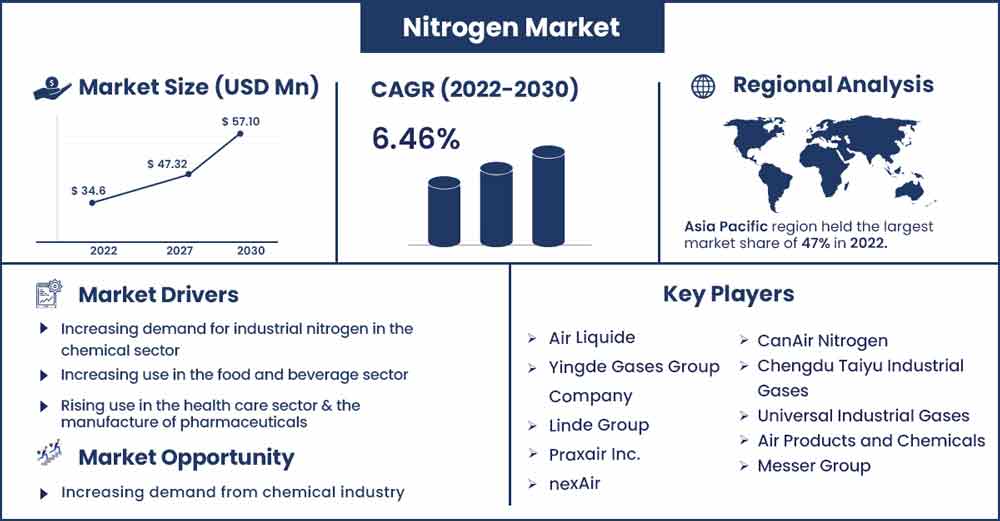November 2025
The global nitrogen market size exhibited USD 34.6 billion in 2022 and is projected to increase USD 57.1 billion by 2030, poised to grow at a CAGR of 6.46 percent during the projection period from 2022 to 2030.

The primary element driving the nitrogen market growth rate is its application as a retention agent in the food and beverage sectors. The expanding population of the area with high disposable incomes and developing industrialization, which will further pave the way for market expansion, are likely to temper the growth of the industrial nitrogen market over the forecast period. Additionally, because of its ability to keep food fresh and extend its shelf life, industrial nitrogen is now more necessary than ever, which is predicted to slow the growth of the industry as a whole.
Report Highlights:
Nitrogen Market Report Scope:
| Report Coverage | Details |
| Market Revenue in 2023 | USD 36.84 Billion |
| Projected Forecast Revenue in 2030 | USD 57.1 Billion |
| Growth Rate from 2022 to 2030 | CAGR of 6.46% |
| Largest Market | Asia Pacific |
| Base Year | 2022 |
| Forecast Period | 2022 To 2030 |
| Regions Covered | North America, Europe, Asia-Pacific, Latin America, and Middle East & Africa |
Regional Snapshots:
The biggest market share was held by the Asia-Pacific in the nitrogen market during the forecast period. Due to its rapid industrialization, particularly in end-use sectors like food and beverage, which is expected to drive regional market expansion, the Asia Pacific region held the largest share. The region's market opportunities are also increased by the adoption of improved nitrogen production techniques. Additionally, it is anticipated that throughout the projection period, this area would exhibit the quickest CAGR. This is linked to a growth in utilization in the region across a variety of industries, including food packaging and pharmaceuticals. China and India are now the top two consumers of nitrogen.
Additionally, it is projected that during the next years, the healthcare system in this area would improve, increasing the need for nitrogen. Additionally, it is estimated that throughout the forecasted period, the market would develop due to the expanding usage of fertilizers with an ammonia base in agricultural nations to improve soil fertility. The area's growing industrialization is also predicted to drive market expansion, notably the rise of end-use industries like food and beverage. The market's prospects in the region are additionally enhanced by the deployment of better nitrogen manufacturing methods.
Market Dynamics:
Drivers:
The market for nitrogen is expanding in part due to the expanding food and beverage industries. In the food and beverage business, nitrogen gas is frequently utilized to package food products. The cornerstone of food preservation and its primary method is freezing. Liquid nitrogen spray freezing makes advantage of the vast amount of heat that is absorbed during the gasification process. With rapid heat transfer or quick freezing rates, the amount of time a food product spends in the maximum crystal-forming temperature range throughout the NF process is brief, producing tiny and evenly dispersed ice crystals. As a result, the food product's natural flavor, aroma, and color are preserved to the maximum possible extent.
The food product's shelf life is increased by chilling or freezing it during preservation. The food business uses liquid nitrogen primarily to freeze baked goods, meat, poultry, fish, prepared meals, vegetables, and fruits. Nitrogen gas prevents oxygen from coming into touch with the food item, extending the shelf life of the food by preventing oxidation. This helps to retain the quality of the food by preventing food deterioration. Additionally, nitrogen is frequently used in the food and beverage sectors for packaging and food aeration. Additionally, nitrogen is used in the wine industry to safeguard product quality by preventing oxidation throughout the fermentation process.
Restraints:
The lack of global regulations governing the uses of nitrogen is anticipated to hinder the market during the projected period. Regarding the use of industrial nitrogen, various regulations apply in every nation. Companies find it challenging to comply with these local restrictions. The industrial nitrogen market is thus being restrained as a result of this deterring investment.
Opportunities:
The demand of nitrogen in the chemical industry is a lucrative opportunity for the market. Nitrogen gas is a crucial safety safeguard against fire and explosion in the chemical industry, as well as for ensuring product integrity. To reduce the possibility of a fire or explosion, chemical tanks containing flammable or specialized materials are frequently coated with nitrogen gas. Nitrogen gas will also be pumped into the tank head area at chemical processing and storage plants to completely remove the possibility of product deterioration or contamination. Nitrogen gas is often the pressure transfer gas of choice for moving goods between tanks and is frequently used to sparge unwelcome impurities from a liquid.
Challenges:
The use of nitrogen gas is constrained by how difficult it is to handle. Workers or employees should get training on the handling and storage of nitrogen before dealing with it. Because OZONE and Nitrogen combine explosively. It is the user's entire obligation to keep it in cold, well-ventilated spaces in firmly closed containers.
Recent Developments:
Major Key Players:
Market Segmentation:
By Product Type
By Application
By End-User
Buy this Research Report@ https://www.precedenceresearch.com/checkout/2264
You can place an order or ask any questions, please feel free to contact at sales@precedenceresearch.com | +1 9197 992 333
November 2025
October 2025
July 2025
July 2025